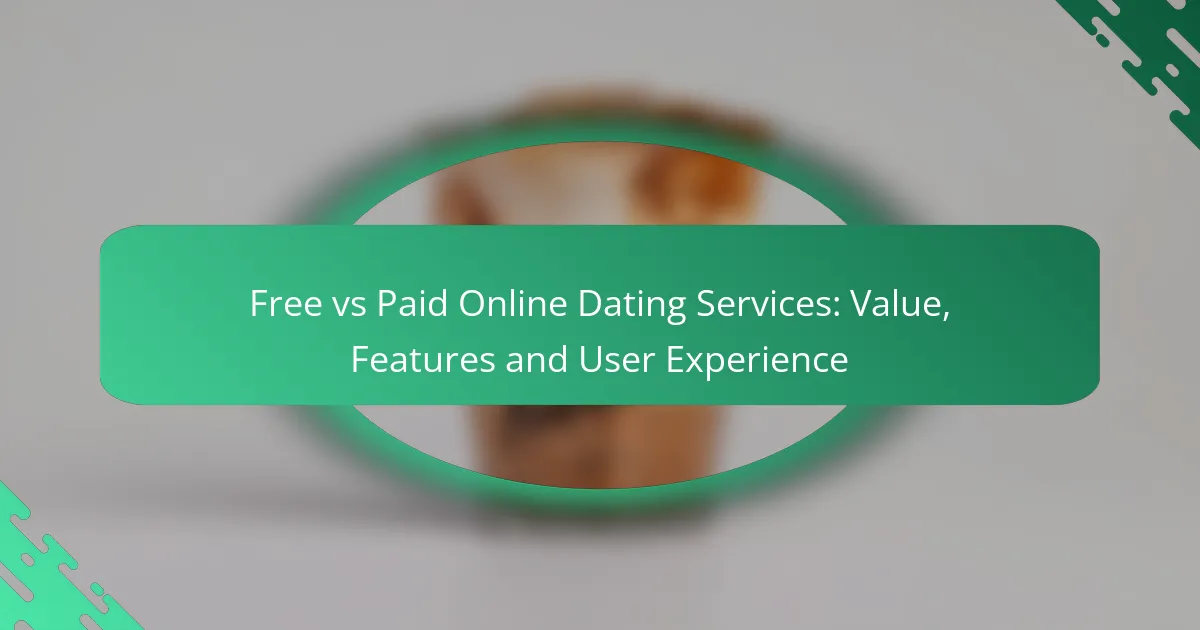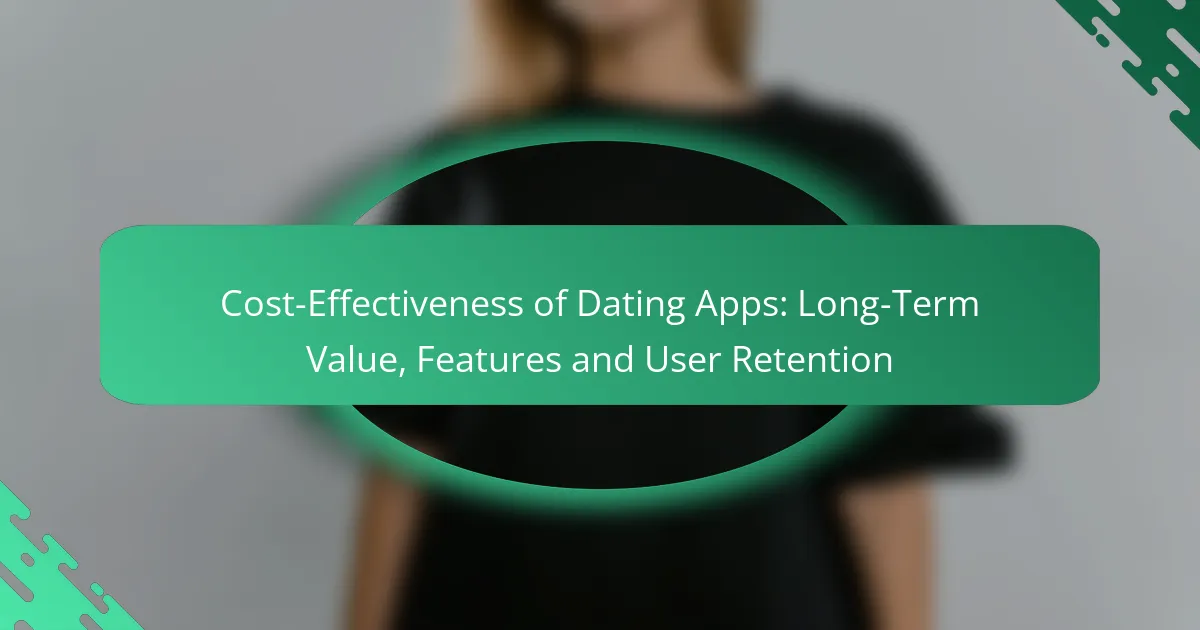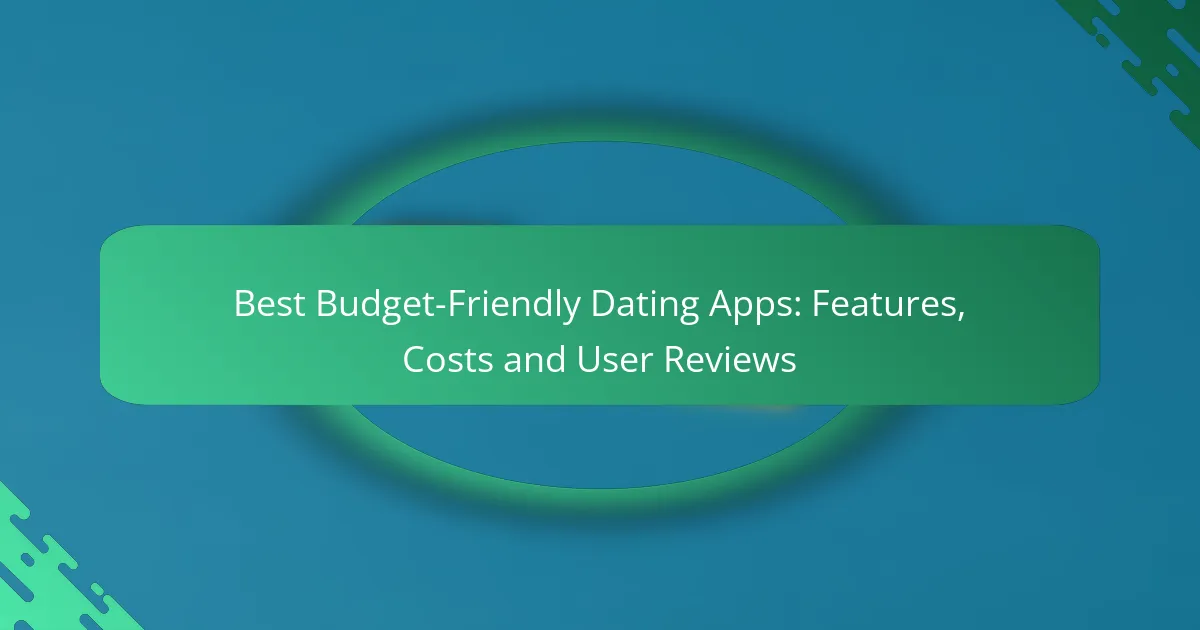When it comes to online dating, the choice between free and paid services can significantly impact your experience. Free platforms often provide basic functionalities and a large user base, while paid services typically offer advanced features that enhance matchmaking and user safety. Understanding these differences can help you make an informed decision about which option best suits your dating goals.

What are the key differences between free and paid online dating services?
The primary differences between free and paid online dating services lie in cost, features, and overall user experience. Free services often provide basic functionalities, while paid options typically offer enhanced features that can improve match quality and user satisfaction.
Cost comparison
Free online dating services do not require any payment, making them accessible to everyone. However, they may have limitations that can affect the dating experience, such as ads or restricted messaging capabilities.
Paid services usually charge a subscription fee, which can range from a few dollars per month to several hundred dollars annually. This investment often translates into a more refined experience, with fewer ads and better customer support.
Feature availability
Free dating platforms often include basic features like profile creation, browsing, and messaging, but may lack advanced options such as detailed search filters or compatibility algorithms. Users might find it challenging to connect with serious matches.
In contrast, paid services frequently offer premium features such as unlimited messaging, advanced matching algorithms, and access to exclusive events. These tools can significantly enhance the likelihood of finding a compatible partner.
User experience
The user experience on free dating sites can be inconsistent, with many users encountering fake profiles or spam. This can lead to frustration and decreased engagement over time.
Paid dating services typically provide a more curated experience. Users often report higher satisfaction levels due to better match quality, enhanced privacy settings, and dedicated customer support, making it easier to navigate the dating landscape effectively.

Which free online dating services are popular in the US?
In the US, several free online dating services stand out for their user base and features. Tinder and Bumble are among the most popular, each offering unique functionalities that cater to different dating preferences.
Tinder
Tinder is widely recognized for its swipe-based matching system, allowing users to quickly browse through profiles. Users can create a profile by uploading photos and writing a brief bio, then swipe right to like or left to pass on potential matches.
One key feature is the ability to chat once both users have liked each other, which encourages mutual interest. While the free version provides essential functionalities, premium features like unlimited swipes and the ability to see who liked you are available for a fee.
Bumble
Bumble differentiates itself by allowing only women to initiate conversations after a match is made, which can create a more comfortable environment for female users. Similar to Tinder, users create profiles and swipe to connect with potential matches.
The app also includes features like Bumble BFF for finding friends and Bumble Bizz for professional networking. While the free version is robust, users can purchase Bumble Boost for extended features like rematching and extending connections.

What are the benefits of paid online dating services?
Paid online dating services offer several advantages, including access to premium features, improved matchmaking, and enhanced user safety. These benefits can significantly enhance the overall dating experience and increase the likelihood of finding a compatible partner.
Enhanced features
Paid dating services typically provide enhanced features that free platforms may lack. These can include advanced search filters, unlimited messaging, and the ability to see who has viewed your profile. Such features streamline the dating process and allow users to connect more effectively.
For instance, premium users might gain access to profile boosts, which increase visibility and attract more potential matches. Additionally, some services offer video dating options, making it easier to establish a connection before meeting in person.
Better matchmaking algorithms
Paid online dating services often employ sophisticated matchmaking algorithms that analyze user preferences and behaviors to suggest more compatible matches. These algorithms can consider various factors, including interests, values, and relationship goals, leading to higher-quality matches.
In contrast, free services may rely on simpler algorithms, resulting in less personalized suggestions. Users of paid services frequently report a more satisfying dating experience due to the improved relevance of their matches.
Increased user safety
Safety is a significant concern in online dating, and paid services typically invest more in user safety measures. This can include identity verification processes, background checks, and enhanced reporting features for suspicious behavior. Such measures help create a safer environment for users.
For example, some platforms offer features that allow users to block or report inappropriate messages easily. By prioritizing user safety, paid dating services can foster a more trustworthy community, which is essential for a positive dating experience.

How do user experiences differ between free and paid dating platforms?
User experiences on free and paid dating platforms can vary significantly in terms of features, engagement, and overall satisfaction. Paid services often provide enhanced functionalities and better user support, while free platforms may attract a larger, more diverse user base but with limitations in quality and features.
Success rates
Success rates in online dating can differ between free and paid platforms, with paid services generally reporting higher match success. Users on paid platforms often benefit from advanced algorithms and features that enhance compatibility, leading to more meaningful connections.
Free platforms may have lower success rates due to a higher volume of casual users and limited features. However, they can still be effective for those seeking less serious relationships or casual encounters.
User demographics
User demographics can vary widely between free and paid dating platforms. Free services tend to attract a broader audience, including younger users and those exploring dating for the first time.
In contrast, paid platforms often attract individuals who are more serious about finding long-term relationships, typically including a higher percentage of older users and those willing to invest in their dating experience.
Customer support
Customer support is usually more robust on paid dating platforms, offering users access to dedicated support teams and quicker response times. This can enhance the overall user experience, especially when issues arise.
Free platforms often provide limited customer support, which may include FAQs or community forums but lack direct assistance. This can lead to frustration for users who encounter problems or need guidance while navigating the platform.

What criteria should you consider when choosing an online dating service?
When selecting an online dating service, consider factors such as your target audience, the features and tools offered, and the pricing structure. These elements will significantly influence your user experience and the likelihood of finding a compatible match.
Target audience
Understanding the target audience of an online dating service is crucial for finding meaningful connections. Different platforms cater to various demographics, such as age, interests, or relationship goals. For example, some sites focus on serious relationships, while others are more casual or niche-oriented, like dating for specific professions or lifestyles.
Before choosing a service, assess whether the platform aligns with your dating intentions. Look for user reviews or demographic data to ensure that the site attracts individuals who share your values and relationship aspirations.
Features and tools
The features and tools available on a dating platform can greatly enhance your experience. Common offerings include advanced search filters, messaging systems, video chat, and compatibility algorithms. Some services may also provide personality assessments or icebreaker prompts to facilitate conversations.
Evaluate which features are essential for you. For instance, if you prefer detailed profiles, look for platforms that allow users to showcase their interests and lifestyles comprehensively. Additionally, consider whether the service offers mobile access, as this can affect your ability to connect on the go.
Pricing structure
The pricing structure of online dating services varies widely, with options ranging from free to premium subscriptions. Free services often come with limitations, such as restricted messaging or fewer profile views, while paid options typically offer enhanced features and a larger user base.
When considering costs, think about your budget and how much you are willing to invest in your dating experience. Many platforms offer trial periods or tiered pricing, allowing you to test features before committing. Be cautious of recurring fees and ensure you understand the cancellation policies to avoid unexpected charges.

How do subscription models impact user engagement?
Subscription models significantly influence user engagement by creating a sense of commitment and access to premium features. Users who pay for a service often feel more invested, leading to increased interaction and satisfaction compared to free users.
Commitment levels
Subscription models typically foster higher commitment levels among users. When individuals invest money, they are more likely to actively participate and seek meaningful connections. This contrasts with free services, where users may treat the platform more casually, leading to lower engagement.
For example, a dating app that charges a monthly fee may see users logging in daily, while a free app might experience users checking in sporadically. This difference can affect the overall quality of interactions on the platform.
Value perception
Users often perceive paid services as offering greater value due to enhanced features and a more serious user base. Subscription models can provide benefits like advanced matching algorithms, ad-free experiences, and exclusive access to events, which can justify the cost.
In contrast, free services may lack these features, leading to a perception of lower quality. Users might find that the investment in a paid service results in better matches and more fulfilling interactions, making it a worthwhile expense.



